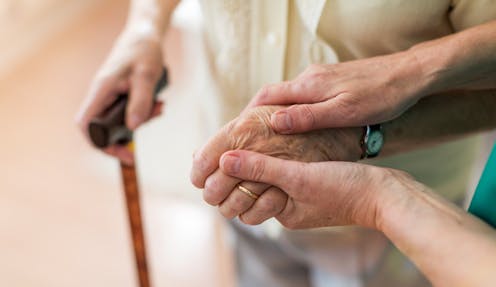Low staff levels must be part of any reviews into the coronavirus outbreaks in NZ rest homes
- Written by Katherine Ravenswood, Associate Professor in Employment Relations, Auckland University of Technology

New Zealand’s residential aged care is the focus of three inquiries to understand why COVID-19 tore rapidly through some rest homes but not others.
These reviews are significant and urgent, but my research suggests they need to pay more attention to caregivers and their concerns about lack of support for quality aged care.
Of the 21 people who have died of COVID-19 in New Zealand, 12 were from one rest home, Rosewood, in Christchurch, another three at St Margaret’s Hospital rest home in Auckland. Of 16 existing clusters of cases, five are in residential aged care facilities, including a second in Christchurch, two in Auckland and one in Waikato.
A review of aged care facilities, led by the Ministry of Health together with the New Zealand Aged Care Association, is expected to report back by the end of May.
An audit of residential aged care homes is also under way, with the ombudsman’s office inspecting dementia units to ensure residents receive adequate care, especially if they have to live in isolation.
Minimal staffing
Rest homes are clearly under huge pressure during the pandemic. Securing supplies and personal protection equipment, managing isolation of vulnerable and sometimes confused residents, increasing cleaning schedules and developing staff rosters to reduce the chance of infection would add stress even in a well-staffed rest home.
But as I outlined to the Australian Royal Commission into Aged Care in February, the legal requirements for staff-to-resident ratios are surprisingly minimal.
Safety standards and the service agreements between district health boards and aged care providers specify high quality of care, with a goal of maintaining independence and social lives for residents that resemble what they experienced when they lived independently.
But this is expected on a prescribed minimum of three care staff on duty at all times – in a rest home with more than 60 residents.
In a small rest home with ten or fewer residents, only one caregiver is required at all times.
Of course, it is possible for a rest home to roster more than the minimum number of staff, but that is not often the case. It is common to have high numbers of residents to one caregiver.
Late last year, before COVID-19 reached New Zealand, a caregiver described to me her experience working in a rest home. She cared for 16 residents on her 3-11pm shift. During that time she had to ensure all 16 were cleaned and put to bed, fed dinner and supper, taken to the toilet and more.
She said it was stressful and there was not enough time to really care for residents. She added:
Bells are continually ringing because those at risk of falling have stood up by themselves; residents may need to be changed because they have soiled themselves and some ring the bell continuously because they are bored and confused. We are expected to answer all but invariably some will have to wait because we are already dealing with others.
A 2016 study reflects this experience. It shows only 58.6% of the caregivers surveyed agreed they had enough time to spend with each resident. A 2019 report into safe staffing levels surveyed more than 1,000 nurses and caregivers and found 73% thought there were not enough staff to provide good care.
Future proofing aged care
If we take this pre-pandemic situation into account, we can see how a virus that disproportionately affects older people would spread fast through rest homes. If each staff member looks after 16 or even 20 residents, how are they going to manage to clean all surfaces three times daily and ensure staff who work with an infected resident keep away from non-infected people and practise good hygiene?
Although the Ministry of Health’s review into rest home clusters mentions staffing numbers, training, qualifications and rosters as part of its scope, the terms of reference make little mention of caregivers or other staff.
This sector has a long history of excluding their caregiver employees – those who do the work and see residents every day – from reviews and negotiations that determine quality of care, funding and staffing levels. This looks set to continue as we examine how residential aged care as a sector, and in individual rest homes, responded to COVID-19.
One beacon of light is the ombudsman’s review into dementia units and the rights of those residents. That review specifically includes employees in consultations as well as interviews about how well supported they feel in the workplace.
This perspective does not take away from the residents and their rights, but recognises under-supported caregivers in understaffed facilities cannot provide quality care.
Last month, the government announced a NZ$26 million funding boost for residential aged care but it was unclear how the money would be used.
A one-off cash injection might add capacity during the pandemic, but it will not solve the persistent issue of low staffing levels – especially if none of the money is earmarked for staffing.
It is time policymakers, funders and aged care providers address the elephant in the room, that quality care requires more staff and more time. Higher staffing ratios will also provide more room for flexibility when crises occur.
Those caregivers (or their representatives) should be given a place at the table. If they had been listened to before, we would have been much better prepared.
Authors: Katherine Ravenswood, Associate Professor in Employment Relations, Auckland University of Technology



















